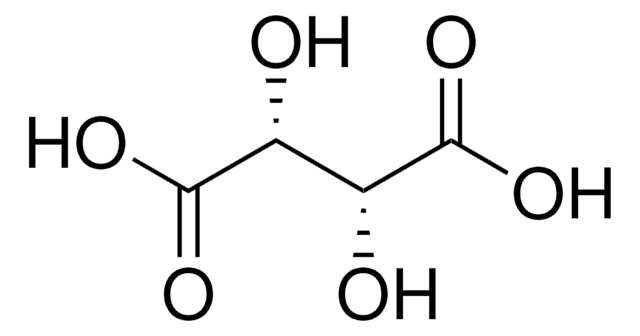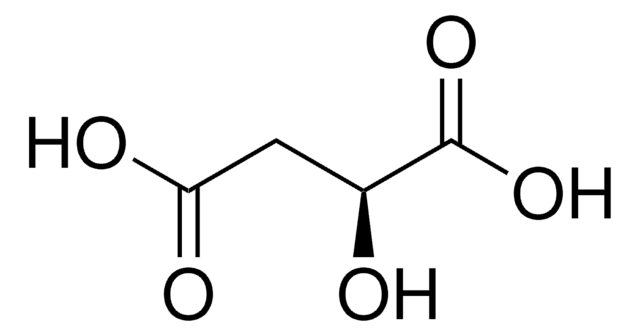33801
L-(+)-Tartaric acid
puriss. p.a., reag. ISO, 99.5-101.0% (calc. to the dried substance)
Synonym(s):
(2R,3R)-(+)-Tartaric acid, L-Threaric acid
About This Item
Agency
Ph. Eur.
USP/NF
reag. ISO
Quality Level
vapor density
5.18 (vs air)
grade
puriss. p.a.
Assay
99.5-101.0% (calc. to the dried substance)
form
powder or crystals
optical activity
[α]20/D +12.0 to +12.8°, c = 20% in H2O
autoignition temp.
797 °F
impurities
≤0.0005% heavy metals (as Pb)
ign. residue
≤0.1% (as SO4)
loss
≤0.1% loss on drying, 105 °C
mp
170-172 °C (lit.)
anion traces
chloride (Cl-): ≤5 mg/kg
phosphate (PO43-): ≤10 mg/kg
sulfate (SO42-): ≤150 mg/kg
cation traces
Ca: ≤20 mg/kg
Cu: ≤5 mg/kg
Fe: ≤5 mg/kg
Pb: ≤2 mg/kg
Zn: ≤5 mg/kg
SMILES string
O[C@H]([C@@H](O)C(O)=O)C(O)=O
InChI
1S/C4H6O6/c5-1(3(7)8)2(6)4(9)10/h1-2,5-6H,(H,7,8)(H,9,10)/t1-,2-/m1/s1
InChI key
FEWJPZIEWOKRBE-JCYAYHJZSA-N
Looking for similar products? Visit Product Comparison Guide
General description
Application
Signal Word
Danger
Hazard Statements
Precautionary Statements
Hazard Classifications
Eye Dam. 1
Storage Class Code
11 - Combustible Solids
WGK
WGK 1
Flash Point(F)
302.0 °F - closed cup
Flash Point(C)
150 °C - closed cup
Personal Protective Equipment
Choose from one of the most recent versions:
Already Own This Product?
Find documentation for the products that you have recently purchased in the Document Library.
Customers Also Viewed
Our team of scientists has experience in all areas of research including Life Science, Material Science, Chemical Synthesis, Chromatography, Analytical and many others.
Contact Technical Service



